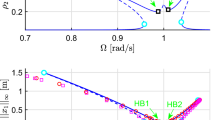Abstract
We prove a result characterizing conditions for the existence and uniqueness of solutions of a certain Diophantine equation, then using techniques from equivariant bifurcation theory, we apply the result to prove symmetric Hopf bifurcation type theorems for both dissipative and non-dissipative autonomous wave equations, for a large set of spatial dimensions. For the latter only the classical implicit function theorem is used. The set of admissible spatial dimensions is the union of the perfect squares together with finitely many non-perfect squares.
Similar content being viewed by others
Notes
When the solution \(\mathbf {m}^{+}\) of the Diophantine equation is unique up to permutation, we will drop it from the parenthesis for \(\omega _{+}\) on the left side.
References
Berti, M., Biasco, L., Procesi, M.: KAM for reversible derivative wave equations. Arch. Ration. Mech. Anal 212(3), 905–955 (2014)
Berti, M., Bolle, P.: Sobolev periodic solutions of nonlinear wave equations in higher spatial dimensions. Arch. Ration. Mech. Anal. 195(2), 609–642 (2010)
Bourgain, J.: Construction of periodic solutions of nonlinear wave equations in higher dimension. Geom. Funct. Anal. GAFA 5(4), 629–639 (1995)
Bourgain, J.: Periodic solutions of nonlinear wave equations with general nonlinearities. In: Harmonic Analysis and Partial Differential Equations, Chicago Lectures in Mathematics, pp. 69–97. University of Chicago Press, Chicago (1999)
Fiedler, B.: Global Bifurcation of Periodic Solutions with Symmetry, vol. 1309. Springer, Berlin (2006)
Golubitsky, M., Stewart, I.: Hopf bifurcation in the presence of symmetry. Arch. Ration. Mech. Anal. 87(2), 107–165 (1985)
Grosswald, E.: Representations of Integers as Sums of Squares, pp. xi+251. Springer-Verlag, New York (1985). https://doi.org/10.1007/978-1-4613-8566-0
Healey, T.J., Kielhöfer, H.: Free nonlinear vibrations for a class of two-dimensional plate equations: standing and discrete-rotating waves. Nonlinear Anal. Theory Methods Appl. 29(5), 501–531 (1997)
Kielhöfer, H.: Bifurcation Theory: An Introduction with Applications to PDEs, vol. 156. Springer, Berlin (2006)
Kosovalić, N.: Quasi-periodic self-excited travelling waves for damped beam equations. J. Differ. Equ. 265(5), 2171–2190 (2018)
Kosovalić, N., Pigott, B.: Self-excited vibrations for damped and delayed 1-dimensional wave equations. J. Dyn. Differ. Equ. 31(1), 129–152 (2019)
Kosovalić, N., Pigott, B.: Uniqueness for sums of nonvanishing squares. Integers 20:Paper No. A93, 11 (2020)
Kosovalić, N., Pigott, B.: Self-excited vibrations for damped and delayed higher dimensional wave equations. Discrete Contin. Dyn. Syst. 39(5), 2413 (2019)
Pall, G.: On sums of squares. Am. Math. Mon. 40(1), 10–18 (1933)
Yuan, X.: Quasi-periodic solutions of nonlinear Schrödinger equations of higher dimension. J. Differ. Equ. 195(1), 230–242 (2003)
Acknowledgements
The authors would like to thank the anonymous referee for their careful reading of this work and for numerous suggestions which improved the readability of the final version.
Author information
Authors and Affiliations
Corresponding author
Additional information
Publisher's Note
Springer Nature remains neutral with regard to jurisdictional claims in published maps and institutional affiliations.
Appendix
Appendix
In this section we provide more details of selected proofs.
1.1 Proof of Proposition 6.6
For \(p\in G^s\) we see that
so differentiating with respect to \(\omega \) yields:
since \(L^{-1}_{\omega }\) gives a derivative according to Proposition 6.5 while \(\partial _{\omega } L_{\omega }\) takes two derivatives, the latter which follows from Eq. (14). Differentiating both sides of Eq. (44) a second time and counting derivatives shows that for \(p\in G^s\), \((\partial ^2_{\omega } L^{-1}_{\omega })p\in G^{s-1}\). Now by Proposition 6.3 since F is smooth as a function in its arguments but “loses a derivative” as the codomain has one less derivative, it follows that the map
is \(C^2\), i.e. although the latter actually lies in \(G^s \subset G^{s-2}\), it is \(C^2\) when viewed as having the larger codomain. Hence the map \({\mathcal {G}}(p,b,\omega , \rho )\) inherits this regularity and by a Taylor expansion argument, it can be shown that the implicit function does too.
1.2 Proof of Theorem 2; Sect. 6.4
First we need to compute the larger kernel \(K'\). As we are working in the space \(H^s\), using the exponential basis, everything in this space has a Fourier expansion of the form
Setting \(L_{\omega _{+}}v=0\) as in Sect. 6.1 this leads to \(|\mathbf {m}|^2=N\), so the modes defining the kernel \(K'\) are precisely those with \(|\mathbf {m}|^2 = N\).
To see that \(\Pi _{K'} {\hat{\varphi }}=\Pi _{K'} \varphi \), we recall from Sect. 6.3 that our solution \(\varphi (\rho )\) is symmetric and has the expansion
where \(\rho \) is a real amplitude parameter,
and \(r(\rho )(x) \in R^{s}\), the \(\text{ Fix}_{S_d} Y^{s}\)-\(L^2\) orthogonal complement of \(K:=\text {Span}\{ \Psi _{\left[ \left[ {\mathbf {m}}^{+} \right] \right] } \}\).
In particular, this may be written in the exponential basis as
for some \(f_{{\mathbf {k}}}(\rho )\). Hence using the above expansion we see that
Finally, to check that the period vector \(\frac{2\pi }{( m^{+}_1+\cdots +m^{+}_d)}{\mathbf {1}}\) is the minimum period vector of \(\varphi (\rho )\), the latter Fourier expansion for \(\varphi (\rho )\) in the exponential basis reveals that any period vector of the form \(T {\mathbf {1}}\) where \(T\in \mathbf {R}\) satisfies \(T\in \frac{2\pi }{( m^{+}_1+\cdots +m^{+}_d)} \mathbf {Z}\) by substitution and comparison of coefficients with the nonzero coefficient coming from the mode \(\mathbf {m}^{+}\).
Rights and permissions
About this article
Cite this article
Kosovalić, N., Pigott, B. Symmetric vibrations of higher dimensional nonlinear wave equations. Sel. Math. New Ser. 28, 48 (2022). https://doi.org/10.1007/s00029-022-00761-7
Accepted:
Published:
DOI: https://doi.org/10.1007/s00029-022-00761-7
Keywords
- Symmetric Hopf bifurcation
- Diophantine equation
- Wave equation
- Symmetric group action
- Lyapunov–Schmidt reduction
- Implicit function theorem



